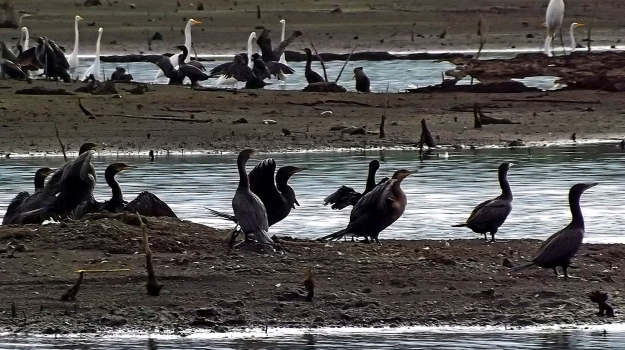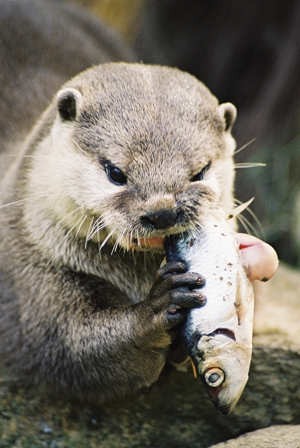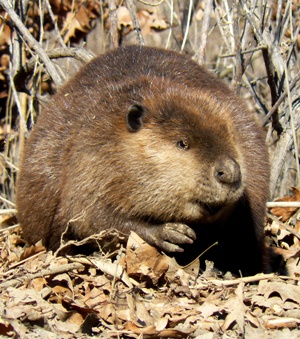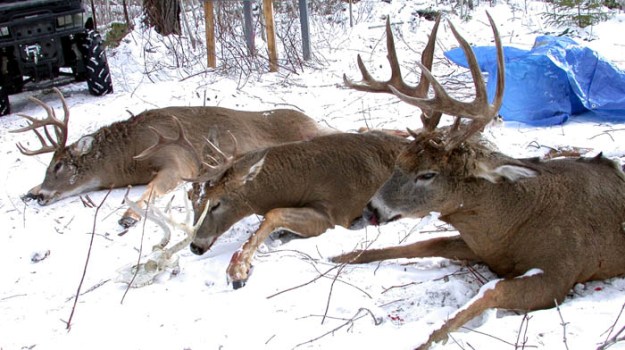
These Three Foes may be Stealing your Resources
By Jill J. Easton
It’s you against them and they have all the advantages. They can swim faster, dive deeper, build bigger and eat more in a day than you can imagine. Cormorants, otters and beavers can quickly change a thriving pond into a vast water wasteland. What do cormorants and other fish-eating birds like great blue herons have in common with otter and beaver? If you have a pond or lake on your property you may already know. Each of these critters in its own way can turn your pond from a healthy and thriving fish haven into a giant mud puddle.
“To maintain a successful pond or lake property owners must have engaged management,” said Rex Martensen, the Private Land Services Field Program Supervisor for Missouri Department of Conservation. “Don’t just check on your pond once or twice a year, make sure everything is ok frequently. Be there and be aware.”
If a landowner doesn’t know how to deal with a pond predator problem the first step is to contact their state game and fish agency. A call to the state office will often provide a wealth of information on how to deal with pond problems and specific resources that are available. For federally protected animals like cormorants the first call should be to Wildlife Services, a division of the Department of Agriculture, Animal and Plant Health Inspections Service (APHIS).
Cormorants and herons
If a flock of cormorants or a great blue heron or two decides to make your pond home, it is an immediate problem because they eat fish and lots of them.
“The double-crested cormorant, and the herons, have gone from depressed populations, where seven states had them on the state threatened list, to overabundant in the entire Eastern United States,” explained Thurman Booth, Arkansas Wildlife Services State Director for APHIS. “Once DDT and other persistent chlorinated hydrocarbons were banned, egg shell thinning which was limiting reproduction for most birds at the top of the food chain vanished.”
These birds currently have no enemies other than man and they have taken advantage of the situation.
“Serious depredation on southern aquaculture and northern sport fish populations has been the result,” Booth said. “Studies in the catfish ponds of the south and on the Great Lakes have verified this. Oiling eggs at rookeries on islands in the Great Lakes and removal of nesting birds in the south are beginning to result in reduced depredation.”
Cormorants are about two to three feet long with a wicked hook at the tip of their bill. They have relatively short legs and webbed feet. Most subspecies are dark with green eyes. When swimming on the surface they float low in the water so only the neck and head is visible from a distance. Cormorants excel as underwater swimmers. They use their webbed feet to paddle swiftly underneath the surface.
In Asia fishermen put a ring around the cormorant’s neck so it is unable to swallow any fish it catches, and then the birds are put in the water on a long leash. When the cormorant catches a fish, the bird is dragged back to the boat where the fisherman pulls the fish out of the bird’s gullet then sends it out to find another fish. In some areas they are known as pig ducks because they grunt while sunning or when disturbed.
After hunting, cormorants spend hours on snags and bars near water with their wings outstretched drying their plumage and grunting at each other. When they are dry they preen oils back into their feathers. A single cormorant may do little damage, but there is never just one cormorant.
Great blue herons, the other major flying pond predator, are about four to five feet high, with a blue-gray color, sharp yellow bill and long yellow legs that end in unwebbed feet. These are stealth predators; they stand frozen in the shallows until a fish, frog or crawfish comes by, then strike with lightning speed and pinpoint accuracy. Except during nesting, herons are solitary hunters.
Fish-eating birds are a serious problem for fish farms and large stocked ponds, but they can also make the life of a small pond owner miserable.
When ponds are infested with these birds, high levels of e-coli, plus bad smells from rotting fish parts and the bird’s feces make the pond an unpleasant place.
Just make them go away
The best tool for keeping herons and cormorants out of your pond is harassment. Loud noises and people presence does a lot to keep fish-eaters winging away to someone else’s property. “Use everything in your toolbox to discourage these birds,” Martensen said. “Cut down snags and dead tree branches around the water, hang flagging or foil that will blow in the wind, use noisemakers (like air cannons or Bird Whistlers which are now legal to use without an explosives license) to make the water less attractive to them. You can’t let them rest.”
If the noisemakers don’t work, Stan Kirkland, Public Information Officer with Florida Fish and Wildlife Conservation Commission has suggestions to short stop the birds underwater.
“FWC staff biologists recommend making it more difficult for cormorants to have a "free lunch" by encouraging the growth of vegetation such as lily pads or other submergent plants,” Kirkland says. “They also suggest putting tree tops and logs in the water for fish hiding spots. On smaller lakes of one to two acres, landowners can string fishing line above the water line at intervals of two to three feet to disrupt the flight path of the birds.”
It is also sometimes possible to get a federal depredation permit to kill the birds. Wildlife Services, a division of APHIS in every state, issues these permits. Your state’s office can be found with a simple computer search. Pond owners with problems can get permits year-around that allow trapping, shooting or using other methods to kill these birds.
 Otter
Otter
River otters are sly, successful fish- frog and crawfish-eating machines. The bad news is that a pond owner who doesn’t pay close attention may find his pond emptied of fish-life and never know a traveling otter was the problem. Because of their dense fur, river otters were trapped almost to extinction in many areas, but they have made a remarkable comeback due to good wildlife management and relocation to areas where these large members of the weasel family were extirpated.
Otters are built for swimming, with a streamlined body, short legs with webbed feet, dense dark fur that keeps the animal warm, a tapered tail, small ears, and nostrils that can close underwater. They can grow to be more than five feet long, including tail, and can weight more than 30 pounds. Although otters are usually solitary, females stay with their pups for about a year until the young ones learn fishing and hunting skills.
Adults often eat 25% of their body weight daily and have been known to kill fish for sport. Otters, especially young males, often leave the rivers where they were whelped and travel far up streams until they reach ponds or lakes that have a good fish population and no competition from other otters. “An otter will stick around long enough to clean out all the edibles out of a pond,” said Jim Spencer, a veteran trapper and author of Guide to Trapping. “Then he’ll head out in search of fishier waters.”
Missouri is one of the states that had an otter reintroduction that started back in the early 1980’s. Today they have a thriving population of otter in many parts of the state and the kind of problems that come with fish-eating predators. “Our otter reintroduction has been a rocky road,” said Martensen. “The reintroduction was much more successful than anticipated and they quickly moved away from the rivers and into ponds. This put them in contention with landowners.” Otters are hard to control because they swim well, but also make long trips overland along waterways or across country and through small streambeds.
“Although landowners may not see an otter, it’s easy to tell when one moves into a pond,” Martensen said. “There will be fish heads, bones and crawfish parts along the sides of the pond and piles of otter scat will be found on logs, rocks and points.” Otter droppings are easy to recognize. They contain fish scales, bones and crawfish shell bits. Raccoon scat may be located in the same areas, but they will also contain seeds and fruit parts.
Beaver
Beavers are known for their construction ability. They build dams and lodges out of sticks, trees and pretty much anything else they can haul around. Their dams are built to provide still, deep water to protect against predators, and to float food and building materials. Beavers are dark brown semi-aquatic rodents with a large spatulate tail that is used for navigation and to deliver warning slaps. An adult beaver may weigh up to 80 pounds. A family group of beavers live in a lodge made out of sticks and mud or in a bank den with an underwater entrance. Their primary food is bark and twigs.
When swimming, beavers are often mistaken for otter, but on land the two mammals look totally different. Otters are streamlined for catching fish, while beavers are rounded and heavy bodied. “Beavers (like The Bible says about the poor) are with us always,” said Booth. “When the demand for beaver pelts was high, fur trappers put a hurtin' on them. Now there are few trappers willing to pay the physical price to trap them for low economic return. Beaver problems are an excellent example of the complexity of wildlife management - what used to be a valuable, abundant resource, became rare, now they are an overabundant problem species.”
When a pair of beavers moves into your pond, look out trees. They cut down trees close to the water to use as building material and often chew on more distant trees or girdle and kill them. They also may plug the outflow on pond dams to raise water levels. Their dammed ponds often flood extensive areas and cause damage to nearby buildings and trees.
Help is available
 Both beavers and otters are managed by the wildlife agency in each state. Most states offer tools and/or people to help deal with these problems. When beavers or otters show up and cause problems, your first call should be to your state wildlife authority. Not all states are as user-friendly as Missouri, but every state offers some help with these animals and the state wildlife agency usually issues depredation permits. “When animals become a problem in ponds (in Missouri) we have seven Conservation Contractors around the state help landowners with their difficulties,” said Martensen. “They will figure out what animal is causing the problem and train the landowner on how to take control of that situation.”
Both beavers and otters are managed by the wildlife agency in each state. Most states offer tools and/or people to help deal with these problems. When beavers or otters show up and cause problems, your first call should be to your state wildlife authority. Not all states are as user-friendly as Missouri, but every state offers some help with these animals and the state wildlife agency usually issues depredation permits. “When animals become a problem in ponds (in Missouri) we have seven Conservation Contractors around the state help landowners with their difficulties,” said Martensen. “They will figure out what animal is causing the problem and train the landowner on how to take control of that situation.”
In Missouri if the problem can’t be dealt with on the phone or in a letter, a Contractor often will meet the landowner at his pond, to show him how to tell what animal is causing the problem. “Our Conservation Contractors offer advices on prevention,” Martensen said. “Perhaps an electric fence would keep the animals from getting into or out of the pond,” Wildlife officials may suggest using local trappers and frequently maintain a list of people that do animal damage control work. They also should stress that if it isn’t trapping season the trapper will expect to be paid to take care of the animals.”
If a trapper isn’t the answer, then the Contractor may show the landowner how to set traps and control the animals. “We empower the landowner to take care of his own problems,” Martensen explained. “The contractor shows the landowner how to set traps, where to set traps and provides the landowner with traps at our cost to take out the nuisance animals.”
After a landowner notifies the Missouri Department of Conservation that he is having a problem he can then shoot the beavers or otters on his property. But most states require that the landowner have a depredation permit in hand before killing these animals. Always check with your state’s wildlife agency before taking action.
There you have it - three very different animals, each can cause major damage to your ponds and lakes. But with the help of state and federal game managers and common sense a landowner can win his pond back.
Otter photo credit: Sophie Davis | Dreamstime.com




























